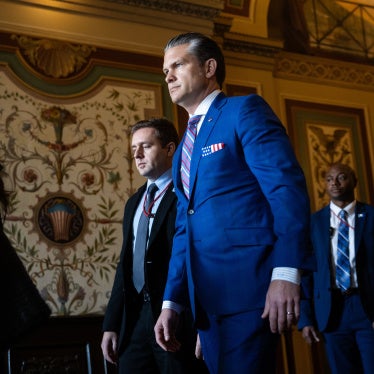We urge the department to take all necessary measures to prevent excessive use of force by the police and to ensure police patrols are undertaken in a manner that does not unnecessarily endanger the lives of residents. In addition, whatever the outcome of any criminal proceedings that may be initiated by the Brooklyn district attorney, we also urge the department to take the appropriate disciplinary actions against the officers responsible for Mr. Stansbury’s death.
As you may know, the use of excessive force (i.e. force that exceeds what is objectively reasonable and necessary in the circumstances confronting the officer) by police officers violates international human rights law as set out in treaties to which the United States is a party. For example, Article 6 of the International Covenant on Civil and Political Rights (ICCPR), affirms that “Every human being has the inherent right to life. This right shall be protected by law. No one shall be arbitrarily deprived of his life.” This treaty provision is binding on all levels of government—federal, state and municipal—and it is the duty of all police officials to uphold it.
We also want to draw your attention to the 1979 U.N. Code of Conduct for Law Enforcement Officials, which provides that: “In the performance of their duty, law enforcement officials shall respect and protect human dignity and maintain and uphold the human rights of all persons…”(Article 2) and “Law enforcement officials should use force only when strictly necessary and to the extent required for the performance of their duty” (Article 3). The U.N. Basic Principles on the Use of Force and Firearms by law Enforcement Officials, adopted in 1990, serve as a guide to the implementation of that code. For example, they provide that:
Governments and law enforcement agencies should develop a range of means as broad as possible and equip law enforcement officials with various types of weapons and ammunition that would allow for a differentiated use of force and firearms. These should include the development of non-lethal incapacitating weapons for use in appropriate situations, with a view to increasingly restraining the application of means capable of causing death or injury to persons. For the same purpose, it should also be possible for law enforcement officials to be equipped with self-defensive equipment such as shields, helmets, bullet-proof vests and bullet-proof means of transportation, in order to decrease the need to use weapons of any kind. (Article. 2)
Law enforcement officials, in carrying out their duty, shall, as far as possible, apply non-violent means before resorting to the use of force and firearms. They may use force and firearms only if other means remain ineffective or without any promise of achieving the intended result (Article 4).
The principles also call on law enforcement agencies to: “ensure all law enforcement officers receive continuous and through professional training including in the use of force” (Principle 18 and 19); and “give special attention to limiting the use of force and firearms and to review their training programs and operational procedures in light of particular incidents” (Principle 20).
While we welcome the immediacy with which you acted to address this most recent tragic death, we hope you will move forward decisively to prevent any future unjustified police shootings. It is imperative that the department review specific policies and procedures, such as patrolling with unholstered guns, that apparently played a role in the tragic shooting. But it is equally imperative that the department continue its efforts to ensure that officers have the cultural and racial sensitivity and the familiarity with community life that will help preclude hasty and fatal reactions involving the use of force.
In light of the above, we therefore recommend you:
- Halt the practice of routine patrolling with weapons drawn until your department’s review of the practice is completed;
- Assess the merits of increasing police use of non-lethal debilitating devices;
- Investigate and assess the training officers receive regarding when weapons should be drawn and the use of lethal force;
- Expand training for officers in community policing and racial sensitivity
Again, we recognize your commitment to ensuring New York’s police officers protect lives and rights of New York City’s residents.
Sincerely,
/s/
Jamie Fellner, Esq.
Director, U.S. Program







